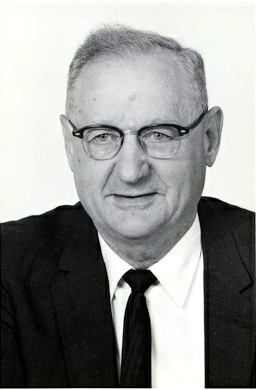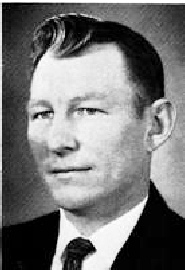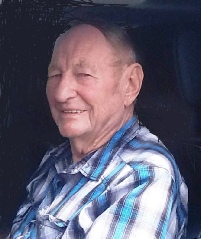
Union Township
Ringgold County
Iowa
Quentin V. Anderson
Harley A. Wilhelm
Ellston School


Quentin V. Anderson, born May 7, 1932, is the eldest son of George and Lena Anderson.
Quentin grew up on a farm east of Ellston, attending the Ellston Community School,
graduating in 1949. He went on to attend the American Institute of Business and serve
in the US Army. Quentin was united in marriage with Rita (Hewlett) of Grand River
on October 20, 1957. They had two children; Clinton in 1964 and Cherri (Vos) in 1970,
raising them on a farm near Ellston. In addition to farming, Quentin has owned and
operated several businesses; dirt construction, building construction, grain elevator,
farm equipment business, bowling alley at Bethany, MO and is a member of the Community
of Christ Church. Quentin was elected to the Iowa Legislature and served six years
in the House of Representatives and four years in the Iowa Senate, during the years
of 1962-
Harley Wilhelm was born August 5, 1900 to Bert and Annabelle Wilhelm. Harley grew
up the third of 7 children raised on various rented-
on Saturday nights in Ellston. The children also played in the school orchestra.
Harley put his farm muscles to work as a star athlete, playing varsity sports as
a freshman and being an all-
n February 1942, with the United States engaged in World War II, Arthur H. Compton established the Metallurgical Laboratory at the University of Chicago as part of the Manhattan Project, to build nuclear reactors to create plutonium that would be used in atomic bombs. He recruited Frank Spedding from Iowa State College as the head of the Metallurgical Laboratory's Chemistry Division. In turn, Spedding established a branch Metallurgical Laboratory at Iowa State College, and recruited Wilhelm as Associate Director to lead the metallurgical research. Spedding and Wilhelm began looking for ways to create the uranium metal. The Ames team found that molten uranium could be cast in a graphite container. They then investigated a process (now known as the Ames process) involving mixing uranium tetrachloride. His uranium extraction process helped make it possible for the Manhattan Project to build the first atomic bombs.
After World War II, Spedding and Wilhelm founded the Institute of Atomic Research
and the Ames Laboratory of the Atomic Energy Commission. Wilhelm became its associate
director in 1945, serving in that capacity until 1966. He remained the principal
scientist and professor of chemistry and metallurgy until he retired in 1970, at
the mandatory retirement age of 70. Harley continued on the faculty at ISU from which
he retired as Professor Emeritus in 1971, helping to establish the United States
Department of Energy's Ames Laboratory at Iowa State University. His work at the
Ames Laboratory included a wide range of subjects, from the design of high-
Wilhelm’s accolades included being part of the United States delegation to the 1955
International Conference on the Peaceful Uses of Atomic Energy in Geneva, receiving
the Eisenman Award from the American Society of Metals in 1962, and the Gold Medal
from the American Society of Mechanical Engineers in 1990, but he was more celebrated
for his achievements as an athlete. In 1961, he was named one of the 100 greatest
athletes in Drake University's history. He was one of 32 Drake alumni athletes who
received the first Double D Awards in 1968, and he was inducted into the Iowa Boys
High School Basketball Hall of Fame in 1988. In 2006, he was one of 80 basketball
players selected as part of Drake University's all-
Harley and Orpha maintained their home in Ames, Iowa and raised their four children, eventually having 10 grandchildren. Orpha died in 1991 and Wilhelm died in the Story City Memorial Hospital on October 7, 1995.
Forty-
In 2019, Quentin manages his farm land & continues to build community.
State Representative
Quentin V. Anderson
in 1963
Brought to you by NERA . Northeast Ringgold County Alliance. Foundation . Established in 2008 . Serving residents in Northeast Ringgold County . Iowa

| Ellston Businesses |
| Area Businesses |
| Restaurants |
| Ellston City Hall |
| Union Township |
| Union Township Minutes |
| American Legion |
| Ellston Library |
| Union Township Fire Fighters |
| United Methodist Church |
| Philanthropic Organizations |
| Blackmore CornerAntique Farm Show |
| Christmas on Main |
| Ellston Museum Day |
| Grand River Rodeo |
| June Jamboree |
| July 4th, Celebrate at the Lake |
| Tingley Halloween |
| Dirt Biking & 4-Wheeling |
| Ellston City Park |
| Grand River Water Trail |
| Sand Creek Wildlife Refuge |
| Sun Valley Golf Course |
| Sun Valley Lake |
| Ellston Cemetery |
| Pumptown Cemetery |
| School & Alumni |
| Dragoon Trace |
| Dragoon Trace Brochur |
| Cornwall Pioneer Home |
| Hazel Glen Rural School |
| Old Telephone Factory |
| Ellston Businesses |
| Area Businesses |
| Restaurants |
| Ellston City Hall |
| Union Township |
| Union Township Minutes |
| American Legion |
| Ellston Library |
| Union Township Fire Fighters |
| United Methodist Church |
| Philanthropic Organizations |
| Blackmore CornerAntique Farm Show |
| Christmas on Main |
| Ellston Museum Day |
| Grand River Rodeo |
| June Jamboree |
| July 4th, Celebrate at the Lake |
| Tingley Halloween |
| Dirt Biking & 4-Wheeling |
| Ellston City Park |
| Grand River Water Trail |
| Sand Creek Wildlife Refuge |
| Sun Valley Golf Course |
| Sun Valley Lake |
| Ellston Cemetery |
| Pumptown Cemetery |
| School & Alumni |
| Dragoon Trace |
| Dragoon Trace Brochur |
| Cornwall Pioneer Home |
| Hazel Glen Rural School |
| Old Telephone Factory |